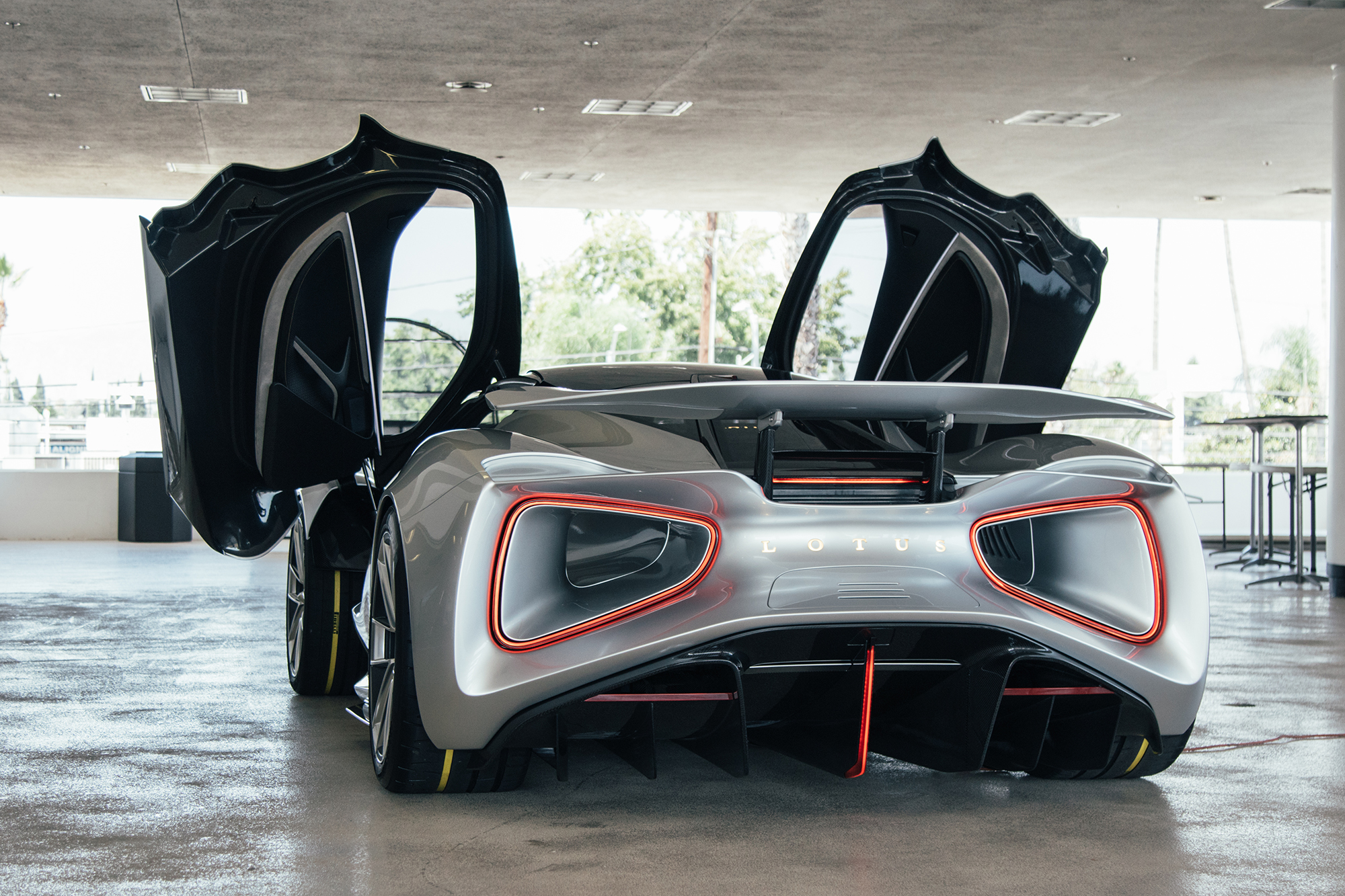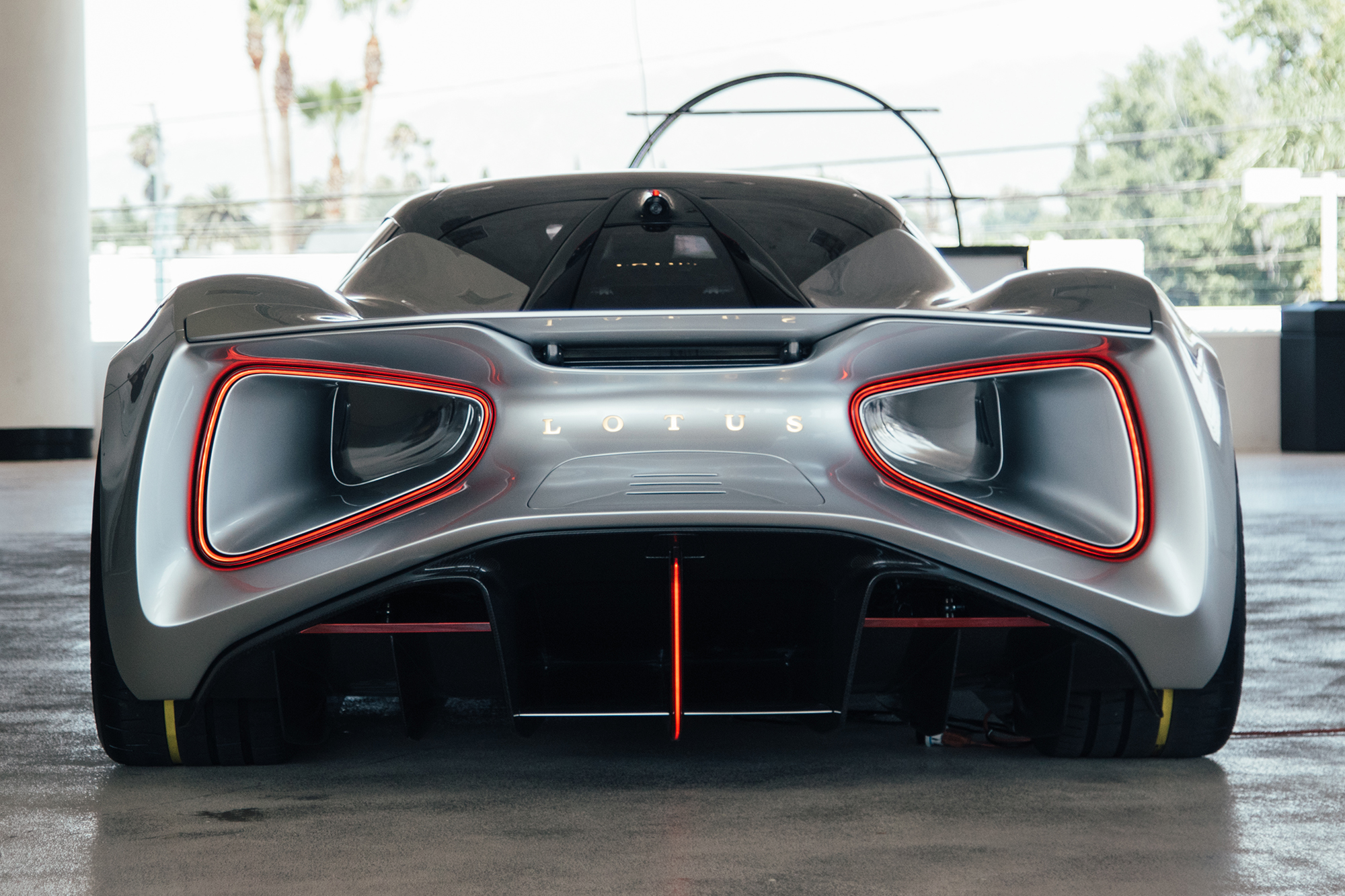

What the mind conjures up when it hears the name Lotus cannot be predicted. There’s too much to its parabolic showroom history, its waxing and waning influence on motorsport to reliably land in the same place every time. Maybe you’re peering into the exposed suspension of the Lotus Seven, or swooning over the black and gold of the JPS Type 72. Maybe it’s the angular Espirit Turbo scything into view, or the cheery Elise sliding by. All icons—but whatever just drove into your head, the uniting thread is sewn in the past.
That historic image is what Lotus needs to change. They say legends never die, but they can definitely go bankrupt, and Lotus knows a thing or two about the struggle. The bootstrapping British automaker has pinballed from one fiscal crisis to another under a succession of owners since the late 1970s, a nauseating ride that finally ended in 2017 in the arms of Chinese conglomerate Geely. Say what you will about the arrangement. Just know it’s the reason there’s still a Lotus, and that it has enough cash to define itself with something truly crazy like the 1,972-hp, all-electric Lotus Evija hypercar. So this is the future.

“There’s a temptation for people to think it’s all Downton Abbey over in Britain.” Russell Carr, head of design at Lotus, says with a laugh. “We’re doing modern stuff. We’re able to run on the cutting edge. And we’re trying to celebrate that with this car.”
It’s hard to think of a stronger statement of purpose than a $2.1 million electric railgun whose 70 kWh battery and quad motor powertrain will make it the most powerful production car on the planet. The other highlights are just as nutty: Zero to 60 mph in under three seconds. 800 kW charging for 0-100 percent in nine minutes. Top speed of over 200 mph. Sophisticated aerodynamics including a mechanical drag reduction system that would make an F1 car blush. A carbon fiber monocoque chassis weighing just 284 pounds holding it all together. Modern stuff indeed.
If all goes well, master technicians will begin building the Evija unchanged from this concept at a new facility in Hethel in 2020, and with it a whole new image for Lotus. The Evija is firmly grounded in the traditions and vision of iconoclastic founder Colin Chapman, but to Carr it also crystallizes the automaker’s heroic-yet-scattered ambitions into three simple areas: driving dynamics, aerodynamics, and weight efficiency. Those are the standards by which every Lotus is to be judged going forward. And there will be more Lotuses. Look closely, and some of them are hiding in the Evija.

Driving Dynamics
Lotus’ informal motto—emblazoned on a strip of metal in the Evija’s seats—is “For the Drivers.” That means preserving as much inherent joy as possible in an electric vehicle that’s also capable of launching from zero to 186 mph in nine seconds. To start, Lotus opted to maintain its mid-engine weight balance and resulting character by stacking the heavy lithium-ion battery behind the cabin rather than an underfloor skateboard that most EVs use. The four e-motors provide torque-vectoring all-wheel drive while electrohydraulic steering promises some visceral bite. There’s an inboard spool valve suspension system built by the pros at Multimatic to offer comfort and flat-cornering performance. The battery cooling system is designed to handle seven straight minutes of flat out action; sounds like enough to get ’round a certain race track in Germany.
“The way we design can not only help improve the dynamics, but we can also express those characteristics in the design as well. For all our cars, we try to shrink wrap the form of the car over the mechanicals. So there’s no wasted material,” Carr says. “It looks light, agile, athletic, like the car performs, but also by doing that you save weight, which contributes to the agility of the car. My father [an RAF fighter pilot] used to say this thing about planes. If it looks right, it flies right. He’d say the same thing about cars, and it’s something I remember now.”




He pointed to the “mid-engine” battery stack as a key example of this blend of the technical and the aesthetic. It gives the car classic proportions and better balance, but it also allowed Carr to maximize passenger space and create an airy, comfortable, eminently livable cockpit you might not expect in a car this extreme. Between the wild floating dashboard—a callback to the tube-framed race cars of the 1950s—and postcard-sized rectangular steering wheel, it’s the best interior Lotus has ever assembled, a cool wave of technical luxury that’s just restrained enough to remind you it’s British. Sitting inside, the driving position feels natural and well-considered, while forward visibility is excellent courtesy of the barely-there dash and low cowl.
“What it does for the driver as well is when you’re inside the car, you really feel like you’re sitting in the car, you’re wearing the car, you can see the fender position to place it on a track,” Carr says.
It also feels remarkably well-assembled for a rolling concept car, boding well for the production version. Where does all this know-how go next? Inevitably quad-motor drivetrains will be the norm for high-performance EVs one day, and the Evija’s development might very well have Lotus at the forefront of that. And the battery comes from a collaboration between Lotus and Williams Advanced Engineering—that Williams—in what should be the first of many battery tuning efforts. Carr promises new models are well underway that will be “equally exciting in their own segments.” He just won’t say what any of them are.
Aerodynamics

“The Evija looks like it’s been carved by air, which is our pompous way of saying that it just looks cool,” Carr laughs.
Honestly, all the marketing speak in the world can’t dim the brilliance of that beautiful rear end, by far the Lotus Evija’s best exterior feature. Twin Venturi tunnels rip back from just behind the dihedral doors, slinking around the rear wheels before exploding out the tail in a striking parallel display. Taillights encircle the openings in fiery arcs that mimic a jet’s afterburners. It’s beautiful—and all part of Lotus’ quest to regain the aerodynamic edge on the street that it once possessed in racing with projects like the famed Type 78 ground effects F1 car.
The ease with which the Evija slips through the atmosphere reflects that newfound focus; the future of hypercar design lies in somehow allowing air to pass through the body rather than divert and deflect around it. Jet planes are the new reference point (“We’re obviously looking for downforce, not lift on our cars. We have to get those round the right way.”). Carr walked us through his bag of tricks aside from the Venturi tunnels. The front end is defined by a splitter that directs air into three separate channels for both aerodynamic and battery/motor cooling purposes. The retractable side mirror camera system cuts out a key source of turbulence. Out back are a movable spoiler and the active drag reduction flaps in the center of the lower diffuser like those on an F1 car.




“The aerodynamics guys talk about porosity, transparency, about applying the minimum blockage to the air, keeping the air moving fast so it’s reducing drag. We just thought that visually, your eye should be drawn through the car too.”
Designing for those considerations was always the plan, and that cohesive focus shows in the settled look before you. But Carr is very upfront that form can only follow function to a certain point. He’s adamant that a Lotus must always be beautiful, and so his team ended up finding inspiration in nature—things like ice caves, or a coastal cliff worn smooth—to make those aerodynamics an essential part of the form. Carr’s also a big Norman Foster fan, especially of the way the architect “celebrates the structure,” an idea that absolutely applies to the Evija’s aero design.

“We didn’t want to create some crazy science fiction design that will go out of fashion. It’s got to be something lasting,” he says. “And there will be certain visual cues that we take from this car which will run onto sports cars, and other cars that perhaps aren’t pure two-seat sports cars that we’ll have going on in the future.”
So Venturi tunnels on that forthcoming Lotus SUV? It’s not impossible.
Weight Efficiency
Colin Chapman was a man obsessed with making every car he touched lighter, a much greater challenge when you’re dealing with the power density of current lithium-ion batteries. Those suckers are heavy. Lotus hasn’t said yet just how much the Evija’s 70 kWh battery weighs, but it’s telling that the company opted to maximize a lower density battery with Williams’ help rather than stuff a 100+ kWh brick in there to keep the car around 3,700 pounds. That’s relatively heavy for a traditional hypercar but positively featherweight compared to electrics. The Rimac C Two, for example, clocks in at 4,300 pounds. Even a little old Tesla Model 3 tops 4,000 pounds in some configurations.

Still, the Lotus’ battery alone is likely over 1,000 pounds, so the company trimmed fat wherever else it could. One key advancement here is Lotus’ first use of a carbon-fiber monocoque structure in a road car, built by the experts at CPC in Italy. The company claims “the manufacturing process is identical to that of an F1 chassis,” which, sure. Far more relevant are the stones saved by the 248-pound part. Individual components like the magnesium wheels and e-motors themselves have also been stripped, and the driver-focused cabin pays more dividends here with the elimination of unnecessary screens and other frippery.
“All [Chapman’s] cars were beautifully designed as well as technically superlative. So I think he would appreciate that here,” Carr says cautiously when asked how the Man Himself would react to the Evija. “I’d hate to put words in the mouth of a genius who’s no longer here. But we’ve showed his son and his widow the car, and they were very positive about it, so hopefully he would say the same.”

Lightweighting will take on a new importance in the early EV era, and Lotus could easily put itself on the bleeding edge. It’s obvious that its next decade will be filled with cars taking inspiration—material or otherwise—from the Evija. The biggest question mark is whether Lotus can actually get this all done. It’s impossible to consider this grandiose vision without remembering erstwhile CEO Dany Bahar’s disastrous five-concept rollout in 2010 that went approximately nowhere. Admittedly, the circumstances feel entirely different this time around. More relevant here is the idea of Lotus redefining itself with a $2 million hypercar when it’s best known as a thrifty performance brand. Should the Evija hit all its marks, it will indeed put Lotus in a higher echelon, “bang, at the top table,” as Carr puts it. But the company will still need to make room for fans of a $50,000 Elise. Carr says it’s part of the plan.
The math is devastatingly simple now: Just make the lightest version of whatever car it’s making. Or the slipperiest. Or the most fun to drive. Ideally, all three. Lotus in 2019 is cognizant of its sprawling history and the myriad influences it holds, but it also sees its future standing on those pillars. Judge it accordingly.
“It’s about the promise of the potential here. What we’re starting to do now is what we always dreamed of doing, basically,” Carr says with a smile. “I think the work here has just reinvigorated us all. It’s given us focus. It’s given us ambition again. It’s made us question things relentlessly.”